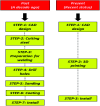A comprehensive review of recent developments in 3D printing technique for ceramic membrane fabrication for water purification
- PMID: 35516413
- PMCID: PMC9064412
- DOI: 10.1039/c9ra00872a
A comprehensive review of recent developments in 3D printing technique for ceramic membrane fabrication for water purification
Abstract
Additive manufacturing (AM), which is also commonly known as 3D printing, provides flexibility in the manufacturing of complex geometric parts at competitive prices and within a low production time. However, AM has not been used to a large extent in filtration and water treatment processes. AM results in the creation of millions of nanofibers that are sublayered on top of each other and compressed into a thin membrane. AM is a novel technique for fabricating filtration membranes with different shapes, sizes and controlled porosity, which cannot be achieved using conventional process such as electrospinning and knife casting. In this paper, we review the advantages and limitations of AM processes for fabricating ceramic membranes. Moreover, a brief background of AM processes is provided, and their future prospects are examined. Due to their potential benefits for fabrication and flexibility with different materials, AM methods are promising in the field of membrane engineering.
This journal is © The Royal Society of Chemistry.
Conflict of interest statement
There are no conflicts to declare.
Figures













Similar articles
-
A review on spacers and membranes: Conventional or hybrid additive manufacturing?Water Res. 2021 Jan 1;188:116497. doi: 10.1016/j.watres.2020.116497. Epub 2020 Oct 5. Water Res. 2021. PMID: 33075598 Review.
-
Additive Manufacturing of Advanced Ceramics Using Preceramic Polymers.Materials (Basel). 2023 Jun 27;16(13):4636. doi: 10.3390/ma16134636. Materials (Basel). 2023. PMID: 37444949 Free PMC article. Review.
-
Ceramic Robocasting: Recent Achievements, Potential, and Future Developments.Adv Mater. 2018 Nov;30(47):e1802404. doi: 10.1002/adma.201802404. Epub 2018 Oct 10. Adv Mater. 2018. PMID: 30306642 Review.
-
3D-Printing Piezoelectric Composite with Honeycomb Structure for Ultrasonic Devices.Micromachines (Basel). 2020 Jul 23;11(8):713. doi: 10.3390/mi11080713. Micromachines (Basel). 2020. PMID: 32717887 Free PMC article.
-
Direct Ink Writing Technology (3D Printing) of Graphene-Based Ceramic Nanocomposites: A Review.Nanomaterials (Basel). 2020 Jul 2;10(7):1300. doi: 10.3390/nano10071300. Nanomaterials (Basel). 2020. PMID: 32630782 Free PMC article. Review.
Cited by
-
Future trends of additive manufacturing in medical applications: An overview.Heliyon. 2024 Feb 23;10(5):e26641. doi: 10.1016/j.heliyon.2024.e26641. eCollection 2024 Mar 15. Heliyon. 2024. PMID: 38444512 Free PMC article. Review.
-
3D-AJP: Fabrication of Advanced Microarchitected Multimaterial Ceramic Structures via Binder-Free and Auxiliary-Free Aerosol Jet 3D Nanoprinting.Adv Sci (Weinh). 2025 Apr;12(15):e2405334. doi: 10.1002/advs.202405334. Epub 2025 Feb 7. Adv Sci (Weinh). 2025. PMID: 39921318 Free PMC article.
-
A Comprehensive Review of Performance of Polyacrylonitrile-Based Membranes for Forward Osmosis Water Separation and Purification Process.Membranes (Basel). 2023 Nov 3;13(11):872. doi: 10.3390/membranes13110872. Membranes (Basel). 2023. PMID: 37999358 Free PMC article. Review.
-
A Novel Approach for the Fabrication of 3D-Printed Dental Membrane Scaffolds including Antimicrobial Pomegranate Extract.Pharmaceutics. 2023 Feb 22;15(3):737. doi: 10.3390/pharmaceutics15030737. Pharmaceutics. 2023. PMID: 36986598 Free PMC article.
-
A review of 3D printing techniques for environmental applications.Curr Opin Chem Eng. 2020;28:173-178. doi: 10.1016/j.coche.2020.08.002. Curr Opin Chem Eng. 2020. PMID: 34327115 Free PMC article.
References
Publication types
LinkOut - more resources
Full Text Sources
Other Literature Sources

